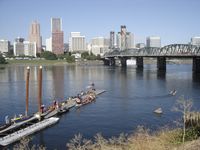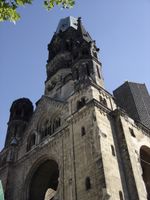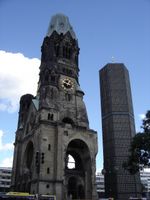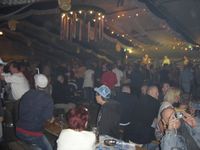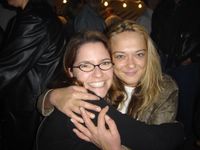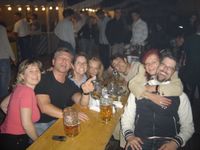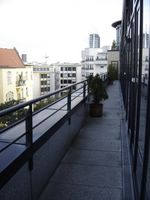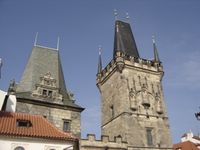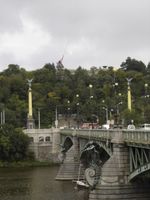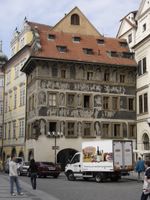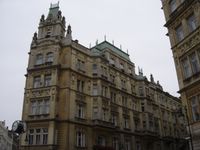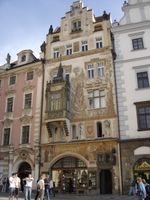I am not a morning person. I never have been. I'm especially this way when I'm
faced with a morning person. When I woke up at 10am, Chris had already been awake for awhile – he said he’d gotten up about 8:30, and was feeling “surprisingly good.” That made one of us.
We just planned to take things very slowly, taking the U-Bahn to the Potsdamer Platz and planning to hop on and off the trains all day long rather than walk. We walked to the nearby train stop and were surprised to find a completely empty station – there wasn’t a soul waiting for a train on either side of the tracks. We briefly questioned whether the trains were even running, but then saw a countdown clock to the next train and figured we were okay. We bought two all-day tickets and got on the next train.
Potsdamer Platz had been taken over by a children’s fair, so we didn’t linger. We walked toward the Reichstag (Germany’s capitol building), noticing along the way that there was an odd double-row of bricks running along the pavement. I say “odd” because it didn’t follow a straight, reasonable line. It didn’t take long to realize that it was marking out the footprint of the former
Berlin Wall. It’s so strange to think of this wall haphazardly placed down the center of streets, through the center of buildings. But more on the wall later. En route to the Reichstag we came upon the rather new
Holocaust Memorial about which I’d seen
a program on Frontline earlier in the year. There was some controversy about its design, as well as the creation of a memorial in the first place. I don’t think any other country has erected a memorial to a genocide its government had a hand in – there’s certainly no memorial to dead slaves or Native Americans in Washington DC – and this one is within sight of the Reichstag.
 The double-brick line that runs through the city, showing the footprint of the wall.
The double-brick line that runs through the city, showing the footprint of the wall.The memorial itself is quite large – a huge field of large concrete blocks of varying heights placed at perfect intervals. From the corner we first approached, it looks like only the height of the blocks varies, but when you begin to wander into the memorial you quickly notice that the floor itself drops away in places, meaning that people disappear completely as they walk toward the center. In addition to the field of blocks, there is also an underground portion that I think is an interpretive and informative center – the line was too long, so we didn’t go downstairs. We learned later that some of the motivations behind the design of the memorial included making the distance between the blocks small enough that it’s not possible to walk side-by-side, only alone; and that each block is of a different height to represent the individual stories of the people who died in the Holocaust. Whatever the motivations, the field reminded both Chris and I of the cemetery in Prague – particularly the unevenness of it.



 Many views of the Holocaust Memorial in Berlin.
Many views of the Holocaust Memorial in Berlin.After our stroll through the memorial, we continued on to the
Reichstag, pausing briefly to look at the backside of the
Brandenburg Gate (the Berlin Wall butted right up against it on the West side, making it an ironic gate to nowhere from the East). The streets all around the Reichstag were blocked off because of the election and there were countless television satellite trucks lining the surrounding roads. The Reichstag has an expansive lawn out in front of it which we think was the setting for more than a few political rallies over the past few weeks. Sunday, however, was election day – and there were only a few television crews set up on the green by that point of the morning. There was a line for tours going into the building itself (apparently the glass dome has some fabulous views of the city), and you’d never have known it was a special day if not for the blocked-off streets and the press.
 The backside of the Brandenburg Gate - this is the side that backed up to the wall. It's hard to see, but in the foreground in the middle of the street is the double-brick line showing where the wall was.
The backside of the Brandenburg Gate - this is the side that backed up to the wall. It's hard to see, but in the foreground in the middle of the street is the double-brick line showing where the wall was.
 The Reichstag, and the satellite trucks camped out next to it.
The Reichstag, and the satellite trucks camped out next to it.A brief aside here as I recall the 1992 U.S. Presidential election. I was studying abroad in the U.K. at the time, and I (like most of my American classmates) had arranged for an absentee ballot and voted by mail. Many of the Americans stayed up late into election night watching the BBC coverage of the results. Because it was so late, our U.K. cohorts weren’t watching with us – but the next day the news was all over not only the international papers but the locals as well. It had never occurred to me that the rest of the world would care, frankly, who was the President of the United States – because I had not heard much about the leaders of other countries. It wasn’t until that election that I realized what an impact the leader of a powerful country can have on the people far beyond his or her borders.
Having said all of that, I can very nearly guarantee that Germany’s elections weren’t on American radar screens. All we’d been seeing on the news for the past couple of weeks was about Hurricane Katrina – even the trampling death of nearly 1,000 Iraqis had been relegated to CNN’s ticker. In Germany, however, the CNN we were getting was European – so the German elections were the top story. I’m still a little fuzzy about how the whole German government works, but after talking politics with our new friends in Munich and Berlin we had some interesting insights. The press analysts were all predicting that the conservative party would take the Chancellorship from the Social Democrats, thereby electing the country’s first woman Chancellor in Angela Merkel. But to a person, no one we talked to thought Merkel would actually win. They all thought her party would win a majority, but that the current Chancellor Gerhardt Schröder would retain his seat. It was noticeable only for the stark difference between what the news folks were saying and what the voters we talked to were saying. (And a week after the election, the results were so close that both Merkel and Schröder were claiming rights to the Chancellorship. It's reminiscent of the 2000 election in the U.S. - an unfortunate mess.)
Anyway, we walked around the outside of the Reichstag building – it was a glorious, sunny day and it’s a beautiful building – an interesting mix of old and new. The building itself has gone through a fair amount of trauma, and there are stone patches where bullets hit it during the Second World War. The glass dome is to the Reichstag what the glass pyramid is to the Louvre – a modern addition to what looks like an otherwise old building (it was rebuilt in the late 1990’s). The line leading into the building soured us on the idea of going inside, so we contented ourselves with the view from the lawn.
 Just behind the Reichstag is this building - I think it's an area called "Museum Island," and we liked this building because it looked see-through with the sky reflected in the glass.
Just behind the Reichstag is this building - I think it's an area called "Museum Island," and we liked this building because it looked see-through with the sky reflected in the glass. The front of the Brandenburg Gate, facing toward the East and the Unter den Linden.
The front of the Brandenburg Gate, facing toward the East and the Unter den Linden.We eventually meandered around the back of the building toward the front of the Brandenburg Gate. The Unter den Linden stretches into what was East Berlin from the front side of the Gate, and prior to WWII it was one of Europe’s grand boulevards. When the Wall went up, it became a deserted “cul de sac” (those are Rick Steves’ words, not mine, but they’re good). In the last 15 years, the street has reclaimed its former glory – it’s reminiscent of the Champs-Elysees, a big open avenue flanked on both sides by streetside cafes and nice shops, and a tree-lined median makes you feel more like you’re taking a walk in a suburban neighborhood than walking down a major street in one of Europe’s biggest cities.
Mainly, the street is the sight here, so we didn’t hurry. The one stop along the Unter den Linden is the Bebelplatz (across from Humboldt University, where Albert Einstein once was a professor), where I had heard there was a subtle and moving memorial to a Nazi book-burning which took place in 1933. The memorial consists of a glass plate in the center of the square that looks down onto empty white bookcases. Unfortunately, the glass has been scratched and is clouded to the point that you can’t see the bookcases unless you’re
really looking for them – and even then it’s difficult. We kind of assume they replace the glass now and again, like you would a car’s windshield, and I hope they replace the glass there soon – it’s a really well-done memorial.
We backtracked along the Unter den Linden a bit and turned off toward Checkpoint Charlie (we were feeling good enough that we opted to walk in the sunshine rather than hop back on the train). The checkpoint itself has been rebuilt to look something like it did during the East-West days, but mostly it’s a crossroads for trinket-selling booths (and most of the trinkets are Soviet in nature). It’s interesting, to be sure, especially to see pictures of the area when the Wall was up, but the best part of that intersection is the House at Checkpoint Charlie.

 At Checkpoint Charlie, there's an interesting display - this small billboard shows a young American soldier facing from the West into the East (left), and a young Soviet soldier facing from the East into the West (right). The rebuilt "Checkpoint" building is in the lower left of the left-hand picture.
At Checkpoint Charlie, there's an interesting display - this small billboard shows a young American soldier facing from the West into the East (left), and a young Soviet soldier facing from the East into the West (right). The rebuilt "Checkpoint" building is in the lower left of the left-hand picture.The Wall went up in 1961 (earlier versions of the Wall consisted of “only” barbed wire, and therefore saw many more escapes), and the people who started the museum had the foresight to set it up in 1962. Certainly, it has evolved over the past 30+ years, but to think that there were many years when you could visit the museum and look out a top-storey window into the East is pretty remarkable. The various creative and dangerous (and sometimes deadly) methods people used to try to escape are all documented – including the many places you can hide a person in a car and how flexible people can be as they squeezed into speaker cabinets. It’s hard to imagine today, just 15 years later, the conditions people in the East lived under – and almost more remarkable is the 180-degree turnaround the East has undergone since the Wall came down.
The Jewish Museum is a short walk from Checkpoint Charlie, but we made it a bit longer than it needed to be. We were trying to find the nearby piece of the Wall that’s still standing in its original place. What’s most interesting about it to me is that it’s not as tall as I would have thought. Obviously, during the years the Wall was not a tourist attraction, there were guards with guns posted every 10 meters or so on the East side, which would have made it seem a
tad more intimidating… But on the West side, even during the Soviet years, people could walk right up to it. We found out later that there were points along the Wall where there were sort of “lookout” points – places where the earth had been piled up high enough that you could walk to the top of a small hill and look down into the East side. It must have been hard enough on people in the East to be able to hear life on the West side of the wall, but then to have residents in the West looking down at you as if you were some kind of zoo exhibit must have been doubly awful. And yet I can understand why young Westerners did it – it was a curiosity, and no one was stopping them.
 Old section of the wall a few blocks from Checkpoint Charlie - this is the East side, where the counterweights extended much further than on the West.
Old section of the wall a few blocks from Checkpoint Charlie - this is the East side, where the counterweights extended much further than on the West.We eventually walked to the
Jewish Museum Berlin, proudly displaying “Two-Millennia of German Jewish History,” which is relatively new and housed in a very interesting building designed by Daniel Libeskind (who has been working on the controversial redesign of New York’s World Trade Center site). It’s a zig-zag of a building that seems completely arbitrary (and perhaps it is), and includes some interesting architectural touches inside as well. We had about 90 minutes before we were scheduled to meet with Chris’ friend Alex (the driver/security guy who had picked me up at the airport the previous week), and though Alex had told us we’d need at least two hours we managed to hit the high points (I think).
When you enter the museum, you’re first directed down a flight of stairs to an underground passageway that is three hallways which intersect at various points. They are called the Axis of Holocaust, the Axis of Exile and the Axis of Continuity. The Axis of Holocaust has the names of concentration camps written on the walls and leads to the dark and cold Holocaust Tower, where there’s a shred of daylight in one upper corner and you can hear the sounds of life outside, but life outside is neither visible nor accessible. The Axis of Exile has the names of foreign cities written on the walls and leads to a slanty outdoor garden of sorts, comprised of 49 concrete pillars filled with earth which have olive willow trees growing out of them, creating a canopy. The Axis of Continuity leads to the long flight of stairs and the museum itself. Like the
Holocaust Museum in Washington D.C., the Jewish Museum is organized so that you begin on the top floor and work your way down.
 The Garden of Exile.
The Garden of Exile.What’s really wonderful about the Jewish Museum is that the focus is on Jewish
life rather than Jewish
death. Certainly, the Holocaust (and other examples of Jewish persecution throughout history) has a place in the Museum, but it’s not overwhelming. All facets of Jewish customs are explained, and there are mini-biographies of many important German Jews throughout history – nearly all of whom I’d never heard of. It’s a very interactive museum, with lots of kid-friendly hands-on displays – there are drawers and doors to open, levers to pull, and (my favorite) you can even find out what your name is in Hebrew letters. Mine is: גסיקה (read from right to left).
 Some of the actual cloth from which the "Jude" badges were cut.
Some of the actual cloth from which the "Jude" badges were cut.
 This was a highlight - if you look closely, you'll see several very personalized yarmulkes in this display, including one with the Cookie Monster, a big smiley face and (my personal favorite) a "Gore/Lieberman" one.
This was a highlight - if you look closely, you'll see several very personalized yarmulkes in this display, including one with the Cookie Monster, a big smiley face and (my personal favorite) a "Gore/Lieberman" one.The building’s architecture is only noticeable in a few areas – mostly you just notice that you’re wandering in what seems like an aimless direction (but is, of course, completely calculated). There are 5 “voids” in the building which you get glimpses of through windows along the walls of the exhibits. The museum’s own literature says this:
“The structure is traversed by a straight line across its main access: an empty space reaching from the basement to the roof. Strictly separated from the building’s remaining space, this 'void' – the term is Libeskind’s – is visible to, but cut off from, the viewer. In its continuous unfolding, the void is meant to structure the building like a backbone, furnishing its unfolding curves with a central axis. Beyond this, through its inaccessibility, the void points toward that which is absent, has vanished – but that still must be made present. In this manner, it architecturally embodies something quintessential to German-Jewish history and culture. In order to move from one area of the museum to another, the visitor crosses more than 30 void-bridges; these offer a view of the empty spaces.”
In the basement there is also an art installment at the bottom of one of the voids, called the “Memory Void” – it’s called “
Fallen Leaves,” and was one of the more powerful elements of the entire visit. I’m not one for modern art, and (generally speaking) especially not interactive art. This installment, however, was remarkable. The space itself is an odd angular shape – if pressed, I might describe it as triangular. The walls are concrete, dark and gray, and it’s probably three stories tall. The only light comes from a window near the top of the room (and one near the entrance of the installation), so the whole thing looks like it’s in black and white. There’s only one way in and out of the space, and when you move toward the back wall you’re completely enveloped in shadow.
The dramatic part, however, is the floor. The entire floor space is covered by faces cut out of iron, one or two deep. They’re simple in design, just circles with eyes, a nose and a large open mouth crudely cut out of them. Every one, despite the common elements, seems individual. And you’re meant to
walk on them. In that high, concrete space, the iron hitting iron under your feet echoes loudly up the walls. It’s uneven footing, so you’re forced to look down as you walk – in other words, you’re forced to
face the faces you’re stepping on. It’s incredibly powerful stuff. From the museum’s website: “While these serve as an architectural expression of the irretrievable loss of the Jews murdered in Europe, [artist] Menashe Kadishman’s sculptures filling them evoke painful recollections of the innocent victims of yesterday, today, and tomorrow.”


 It's hard to not see the message in this beautifully conceived and executed piece.
It's hard to not see the message in this beautifully conceived and executed piece.Really, the entire museum is really interesting and well worth a visit – whether one is Jewish or not. It’s an especially good stop if you’re including concentration camps on your tour, as it provides a nice counterbalance to the most talked-about aspect of being Jewish. There’s much more to German Judaism than dying, and this museum does a brilliant job of telling the rest of the story.
After our visit to the museum we met up with Alex for coffee. He’s a really interesting guy, with an interesting job – he does driving and security work. For Chris, he was doing the driving portion of things; but we think more of his work is actually on the security end. And we didn’t ask many questions, as we figured it’s something that’s probably (ahem) secure. On the list of things we
did talk about, however, was Croatia. He was born in Croatia, and moved to Germany with his family when he was about five, but still has plenty of family “back home” – he waxes poetic about Croatia, a place I’d never thought about vacationing before talking to him. According to Alex, the cleanest and most beautiful water is there, in addition to the best of Italian and Greek architecture. His business partner is also Croatian, and Alex offered the tourism services of the both of them if we ever decide to take a trip there. Honestly, one of the benefits of watching European CNN is the travel advertising – there were ads for Croatia (can you imagine seeing
that on American TV?) that made it look spectacular. We’re planning to get a guidebook and start looking into it. Next year, perhaps?
We finally connected with my aunt's friend Gerrit, who met us at the coffee house with Alex. The four of us sat for a bit before we said goodbye to Alex and went with Gerrit to an Italian restaurant in Kreuzberg, a neighborhood in Berlin, where his girlfriend Nana was waiting for us. They’re both delightful, and we had a great time talking with them. He spent a year on an exchange in the U.S. in a small farming community in Kansas (I cannot imagine going from living in a huge metropolitan city like Berlin to
any town in Kansas), and his English is spectacular. Hers is also fantastic, though she seems more unsure of herself than he does. It was a great meal – for us, it was especially blissful as we could understand parts of the non-English menu for the first time since arriving in Germany, because it was in Italian! We’d love to have them both visit us here, and tried to tempt them with the wonderful things Oregon has to offer – turns out they’re both skiers, so we were quick to point out Mt. Hood’s year-round skiing opportunities… We’ll see how tempted they really were!
After a nice evening with Gerrit and Nana, Gerrit dropped us off at our hotel so we could finish packing - and with that, our trip was coming to an end.




